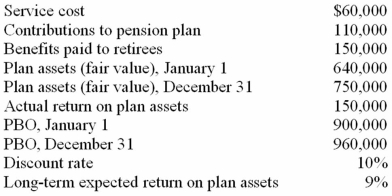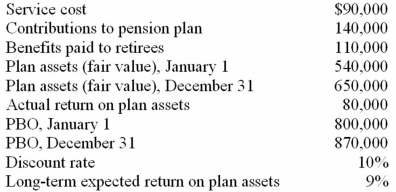A) Employee turnover.
B) Number of employees who retired last year.
C) Future inflation rates.
D) Future compensation levels.
Correct Answer

verified
Correct Answer
verified
True/False
The expected postretirement benefit obligation is the discounted present value of the total benefits expected to be paid by the employer to the plan participants.
Correct Answer

verified
Correct Answer
verified
Multiple Choice
The following information is related to the defined benefit pension plan of Dreamworld Company for the year:  Assuming no other relevant data exist, what is the pension expense for the year?
Assuming no other relevant data exist, what is the pension expense for the year?
A) $190,000.
B) $92,400.
C) $60,000.
D) $170,000.
Correct Answer

verified
Correct Answer
verified
Multiple Choice
Eligibility for postretirement health care benefits usually is based on the employee's:
A) Job title.
B) Number of years in the profession.
C) Number of years in the current position.
D) Age and/or years of service.
Correct Answer

verified
Correct Answer
verified
Multiple Choice
The following information is related to the defined benefit pension plan of Simpson Company for the year:  Assuming no other relevant data exist, what is the pension expense for the year?
Assuming no other relevant data exist, what is the pension expense for the year?
A) $90,000.
B) $230,600.
C) $121,400.
D) $154,000.
Correct Answer

verified
Correct Answer
verified
Essay
On January 1, 2013, Tom's Transport Company's accumulated postretirement benefit obligation was $30,000,000. At the end of 2013, retiree benefits paid were $3,500,000. Service cost for 2013 is $6,000,000. At the end of 2013, there was no prior service cost or net gain or loss. Assumptions regarding the trend of future health care costs were revised at the end of 2013. This revision caused the actuary to revise downward the estimate of the APBO by $500,000. The appropriate discount rate was 6%. Required: Determine the amount of the accumulated postretirement benefit obligation at December 31, 2013.
Correct Answer

verified
Correct Answer
verified
Essay
Lender Company provides postretirement health care benefits to employees who provide at least 10 years of service and reach the age of 65 while in service. On January 1 of the current calendar year, the following plan-related data were available.  On January 1 of the current year, Lender amends the plan to provide dental benefits. The actuary determines that the cost of making the amendment increases the APBO by $20,000,000. Management chooses to amortize this amount on a straight-line basis. The service cost is $40,000,000. The appropriate interest rate is 10%.
Required:
Calculate the postretirement benefit expense for the current year.
On January 1 of the current year, Lender amends the plan to provide dental benefits. The actuary determines that the cost of making the amendment increases the APBO by $20,000,000. Management chooses to amortize this amount on a straight-line basis. The service cost is $40,000,000. The appropriate interest rate is 10%.
Required:
Calculate the postretirement benefit expense for the current year.
Correct Answer

verified
Correct Answer
verified
Multiple Choice
A company's total obligation for postretirement benefits is measured by the:
A) APBO.
B) HMOP.
C) HOBO.
D) EPBO.
Correct Answer

verified
Correct Answer
verified
Multiple Choice
The amount of cash paid annually for unfunded postretirement health benefit plans, assuming they are not independently insured, usually is equal to:
A) The amount required by the actuarial formula.
B) The present value of future benefits.
C) The amount necessary to cover future benefits.
D) The amount necessary to pay the current year's health care cost.
Correct Answer

verified
Correct Answer
verified
Multiple Choice
ERISA made major changes in the requirements for pension plan:
A) Vesting.
B) Reporting.
C) Taxing.
D) Investing.
Correct Answer

verified
Correct Answer
verified
Multiple Choice
Fox Company received the following reports of its defined benefit pension plan for the current calendar year:  The long-term expected rate of return on plan assets is 8%. Assuming no other data are relevant, what is the pension expense for the year?
The long-term expected rate of return on plan assets is 8%. Assuming no other data are relevant, what is the pension expense for the year?
A) $384,000.
B) $360,000.
C) $424,000.
D) $374,000.
Correct Answer

verified
Correct Answer
verified
Multiple Choice
On January 1, 2012, WOW amended its defined benefit pension plan. The amount of prior service costs caused by this action was $720,000. WOW uses the service method for amortizing prior service costs. The following service years were provided by the company actuary: 2012, 20; 2013, 15; 2014, 12; 2015, 8; and 2016, 5. Twenty employees benefit from this amendment. In 2013, the amortization amount would be:
A) $12,000.
B) $180,000.
C) $144,000.
D) $300,000.
Correct Answer

verified
Correct Answer
verified
Multiple Choice
Defined contribution pension plans that link the amount of contributions to company performance are often called:
A) Incentive savings plans.
B) Thrift plans.
C) Savings plans.
D) None of the above is correct.
Correct Answer

verified
Correct Answer
verified
Multiple Choice
The three components of pension expense that are present most often are:
A) Service cost, prior service cost, and gain on plan assets.
B) Service cost, interest cost, and gain from revisions in pension liability.
C) Service cost, contribution cost, and prior service cost.
D) Service cost, interest cost, and expected return on plan assets.
Correct Answer

verified
Correct Answer
verified
Multiple Choice
According to generally accepted accounting principles, accounting for postretirement benefits other than pensions must adhere to the:
A) Accrual basis of accounting.
B) Cash basis of accounting.
C) Modified accrual basis.
D) Modified cash basis.
Correct Answer

verified
Correct Answer
verified
Multiple Choice
Which one of the following assumptions is needed to estimate both postretirement health care benefits and pension benefits?
A) Per capita claims cost.
B) Expected cost trend rate.
C) Benefits provided by other governmental or private plans.
D) Employee turnover.
Correct Answer

verified
Correct Answer
verified
Multiple Choice
Consider the following: I. Present value of vested benefits at present pay levels. II) Present value of nonvested benefits at present pay levels. III) Present value of additional benefits related to projected pay increases. Which of the above constitutes the vested benefit obligation?
A) I & II.
B) I, II, III.
C) II.
D) I only.
Correct Answer

verified
Correct Answer
verified
Multiple Choice
Which of the following describes defined benefit pension plans?
A) They raise few accounting issues for employers.
B) Retirement benefits depend on how much money has accumulated in an individual's account.
C) They are simple to construct.
D) Retirement benefits are based on the plan benefit formula.
Correct Answer

verified
Correct Answer
verified
Multiple Choice
Payment of retirement benefits:
A) Increases the PBO.
B) Increases the ABO.
C) Reduces the GBO.
D) Reduces the PBO.
Correct Answer

verified
Correct Answer
verified
True/False
The amount of the vested benefit obligation is less than the projected benefit obligation and more than the accumulated benefit obligation.
Correct Answer

verified
Correct Answer
verified
Showing 21 - 40 of 197
Related Exams